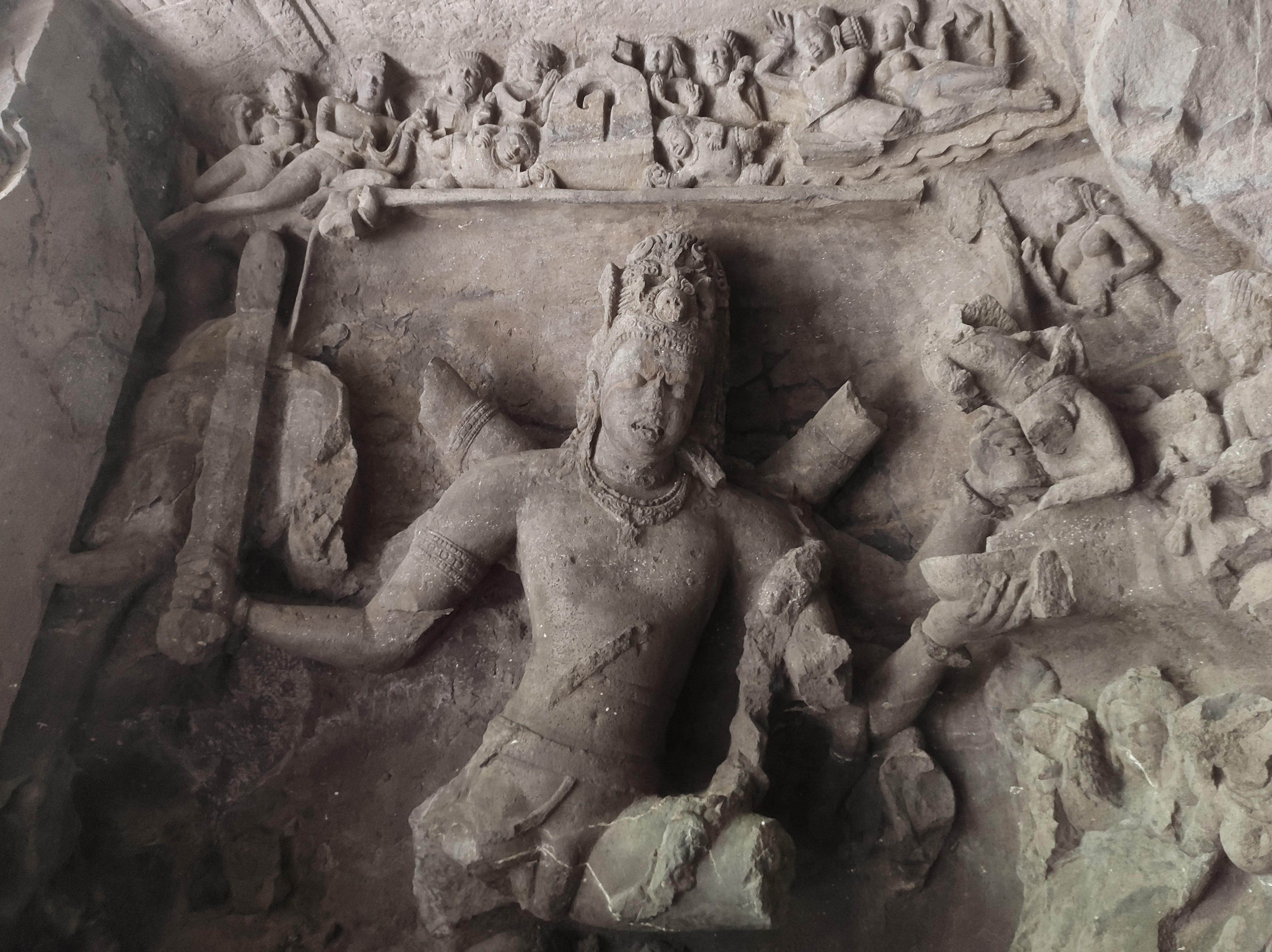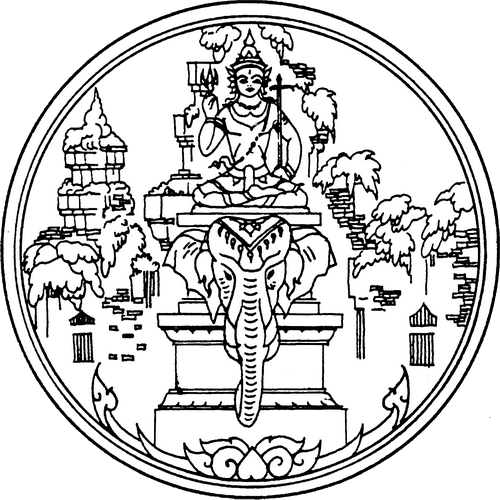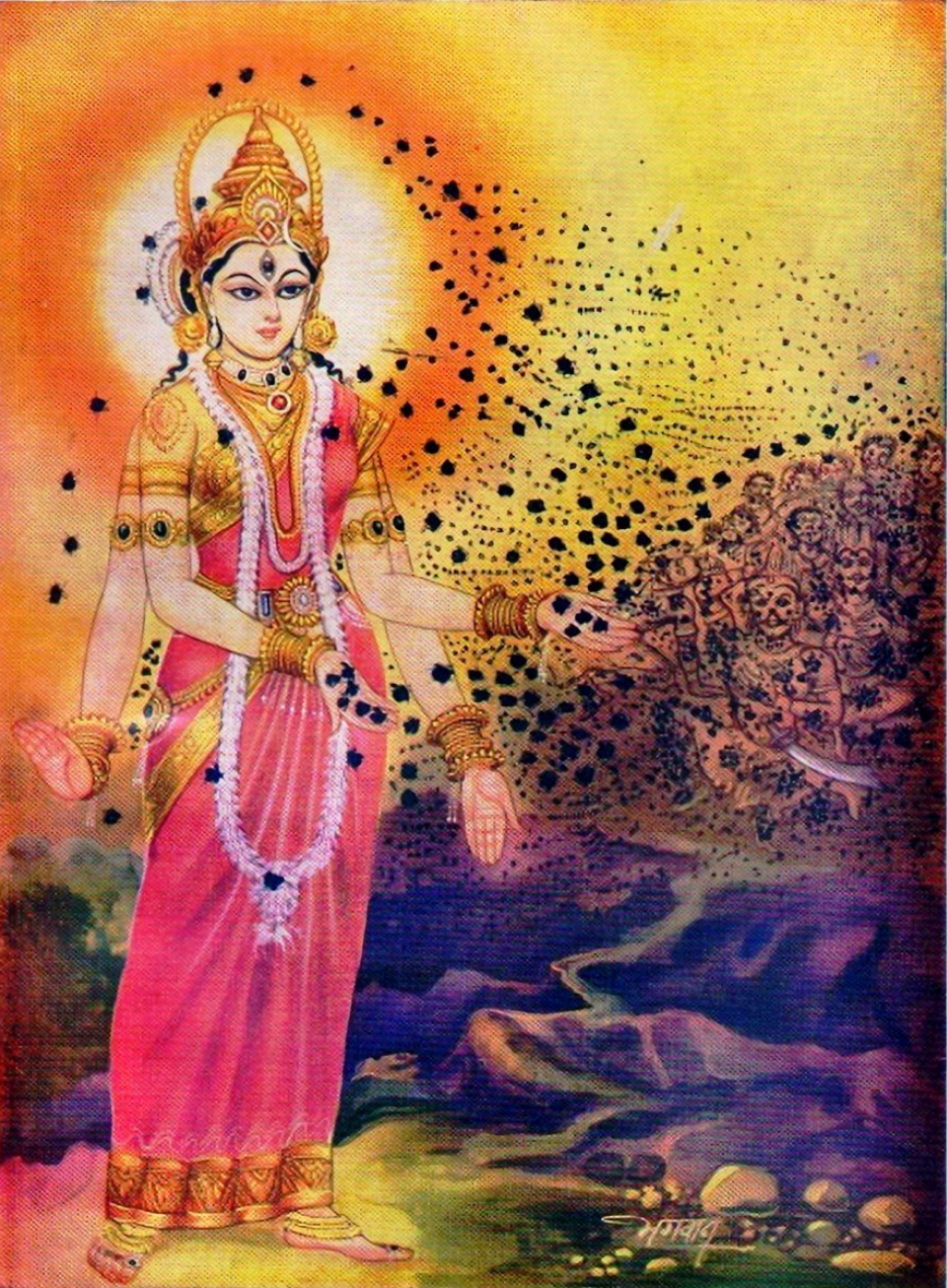|
Bhairavi
Bhairavi () is a Hindu goddess, described as one of the Mahāvidyas, the ten avatars of the mother goddess. She is the consort of Bhairava ( a form of Shiva). Etymology The name ''Bhairavi'' means "terrifying" or "awe-inspiring". Iconography Her dhyana shloka in the Devi Mahatmya describes her form. She wears red garments and wears a garland of severed heads around her neck. She has three eyes and her head is adorned with a crescent moon. Tripura Sundari and Tripura Bhairavi are closely associated but different. Legend Bhairavi is also a title for a female adept in Kundalini, Tantra. A yogini is a student of Tantra or an aspirant. A ''Bhairavi'' has succeeded in Tantra with the help of 64 yoginis. Yogini or Jogini are 64 in number. Yoginis, female supporting deities of Bhairavi. Bhairavi is the supreme leader of all 64 yoginis. Bhairav also has 52 supporting powers called ''52 Bhairav''. Bhairavi is the consort of Bhairava according to the Puranas and Tantras. In Tant ... [...More Info...] [...Related Items...] OR: [Wikipedia] [Google] [Baidu] |
Mahavidyas
The ''Mahavidya'' (, , lit. ''Great Wisdoms'') are a group of ten Hinduism, Hindu Tantra, Tantric Devi, goddesses. The ten Mahavidyas are usually named in the following sequence: Kali, Tara (Devi), Tara, Tripura Sundari, Bhuvaneshvari, Bhairavi, Chhinnamasta, Dhumavati, Bagalamukhi, Matangi and Kamalatmika. Nevertheless, the formation of this group encompass divergent and varied religious traditions that include ''yogini'' worship, Shaivism, Vaishnavism, and Vajrayana Buddhism. The development of the Mahavidyas represents an important turning point in the history of Shaktism as it marks the rise of the Bhakti aspect in Shaktism, which reached its zenith in 1700 CE. First sprung forth in the post-Puranic age, around 6th century CE, it was a new theistic movement in which the supreme being was envisioned as female. A fact epitomized by texts like ''Devi-Bhagavata Purana'', especially its last nine chapters (31–40) of the seventh ''skandha'', which are known as the ''Devi Gita'' ... [...More Info...] [...Related Items...] OR: [Wikipedia] [Google] [Baidu] |
Mahavidya
The ''Mahavidya'' (, , lit. ''Great Wisdoms'') are a group of ten Hindu Tantric goddesses. The ten Mahavidyas are usually named in the following sequence: Kali, Tara, Tripura Sundari, Bhuvaneshvari, Bhairavi, Chhinnamasta, Dhumavati, Bagalamukhi, Matangi and Kamalatmika. Nevertheless, the formation of this group encompass divergent and varied religious traditions that include ''yogini'' worship, Shaivism, Vaishnavism, and Vajrayana Buddhism. The development of the Mahavidyas represents an important turning point in the history of Shaktism as it marks the rise of the Bhakti aspect in Shaktism, which reached its zenith in 1700 CE. First sprung forth in the post-Puranic age, around 6th century CE, it was a new theistic movement in which the supreme being was envisioned as female. A fact epitomized by texts like ''Devi-Bhagavata Purana'', especially its last nine chapters (31–40) of the seventh ''skandha'', which are known as the ''Devi Gita'', and soon became central t ... [...More Info...] [...Related Items...] OR: [Wikipedia] [Google] [Baidu] |
Bhairava
Bhairava (, ), or Kāla Bhairava, is a Shaivite and Vajrayāna deity worshipped by Hindus and Buddhists. In Shaivism, he is a powerful manifestation, or avatar, of Shiva.Kramrisch, Stella (1994). ''The Presence of Śiva''. Princeton, NJ: Princeton University Press. p. 471. In the tradition of Kashmir Shaivism, Bhairava represents the Supreme Reality, synonymous to Para Brahman. Generally in Hinduism, Bhairava is also called Dandapāni (" e who holds thedanda in ishand"), as he holds a rod or ''danda'' to punish sinners, and Svaśva, meaning, "he whose vehicle is a dog". In Vajrayana Buddhism, he is considered a fierce emanation of boddhisatva Mañjuśrī, and also called Heruka, Vajrabhairava, Mahākāla and Yamantaka. Bhairava is worshipped throughout India, Nepal, Indonesia, Sri Lanka, and Japan, as well as in Tibetan Buddhism. Etymology Bhairava originates from the word ''bhīru'', which means "fearsome". Bhairava means "terribly fearsome form". It is also kn ... [...More Info...] [...Related Items...] OR: [Wikipedia] [Google] [Baidu] |
Devi
''Devī'' (; ) is the Sanskrit word for 'goddess'; the masculine form is Deva (Hinduism), ''deva''. ''Devi'' and ''deva'' mean 'heavenly, divine, anything of excellence', and are also gender-specific terms for a deity in Hinduism. The concept and reverence for goddesses appears in the Vedas, which were composed around the 2nd millennium BCE. However, they did not play a vital role in that era. Goddesses such as Durga, Kali, Lakshmi, Parvati, Radha, Saraswati and Sita have continued to be revered in the modern era. The medieval era Puranas witness a major expansion in mythology and literature associated with Devi, with texts such as the ''Devi Mahatmya'', wherein she manifests as the ultimate truth and supreme power. She has inspired the Shaktism tradition of Hinduism. Further, Devi is viewed as central in the Hindu traditions of Shaktism and Shaivism. Etymology ''Devi'' and ''deva'' are Sanskrit terms found in Vedic literature around the 3rd millennium BCE. ''Deva'' is masculi ... [...More Info...] [...Related Items...] OR: [Wikipedia] [Google] [Baidu] |
Mahadevi
Mahadevi (, , IPA: / mɐɦɑd̪eʋiː/), also referred to as Adi Parashakti, and Mahamaya, is the supreme goddess in Hinduism. According to the goddess-centric sect Shaktism, all Hindu gods and goddesses are considered to be manifestations of this great goddess, who is considered as the '' Para Brahman'' or the ultimate reality. Shaktas often worship her as Durga, also believing her to have many other forms. Mahadevi is mentioned as the ''Mulaprakriti'' (Primordial Goddess) in Shakta texts, having five primary forms—Parvati, Lakshmi, Sarasvati, Gayatri and Radha—collectively referred to as ''Panchaprakriti''. Besides these, Goddess Tripura Sundari, a form of Devi, is often identified with the supreme goddess Mahadevi in Shaktism. Author Helen T. Boursier says: "In Hindu philosophy, both Lakshmi (primary goddess in Vaishnavism) and Parvati (primary goddess of Shaivism) are identified as manifestations of this great goddess—Mahadevi—and the Shakti or divine power". ... [...More Info...] [...Related Items...] OR: [Wikipedia] [Google] [Baidu] |
Tantra
Tantra (; ) is an esoteric yogic tradition that developed on the India, Indian subcontinent beginning in the middle of the 1st millennium CE, first within Shaivism and later in Buddhism. The term ''tantra'', in the Greater India, Indian traditions, also means any systematic broadly applicable "text, theory, system, method, instrument, technique or practice". A key feature of these traditions is the use of mantras, and thus they are commonly referred to as Mantramārga ("Path of Mantra") in Hinduism or Mantrayāna ("Mantra Vehicle") and Guhyamantra ("Secret Mantra") in Buddhism. In Buddhism, the Vajrayana traditions are known for tantric ideas and practices, which are based on Indian Tantras (Buddhism), Buddhist Tantras. They include Tibetan Buddhism, Indo-Tibetan Buddhism, Chinese Esoteric Buddhism, Japanese Shingon Buddhism and Nepalese Newar Buddhism. Although Southern Esoteric Buddhism does not directly reference the tantras, its practices and ideas parallel them. In Bud ... [...More Info...] [...Related Items...] OR: [Wikipedia] [Google] [Baidu] |
Kundalini
In Hinduism, kundalini (, ) is a form of divine feminine energy (or ''Shakti'') believed to be located at the base of the spine, in the '' muladhara''. It is an important concept in Śhaiva Tantra, where it is believed to be a force or power associated with the divine feminine or the formless aspect of the Goddess. This energy in the body, when cultivated and awakened through tantric practice, is believed to lead to spiritual liberation. Kuṇḍalinī is associated with the goddess Parvati or Adi Parashakti, the supreme being in Shaktism, and with the goddesses Bhairavi and Kubjika. The term, along with practices associated with it, was adopted into Hatha Yoga in the 9th century. Mallinson, James. "Śāktism and Haṭhayoga." In: Goddess Traditions in Tantric Hinduism: History, Practice and Doctrine, edited by Bjarne Wernicke-Olesen London: Routledge, 2016. pp. 109–140. It has since then been adopted into other forms of Hinduism as well as modern spirituality and New ... [...More Info...] [...Related Items...] OR: [Wikipedia] [Google] [Baidu] |
Yogini
A yogini (Sanskrit: योगिनी, IAST: ) is a female master practitioner of tantra and yoga, as well as a formal term of respect for female Hindu or Buddhist spiritual teachers in the Indian subcontinent, Southeast Asia and Greater Tibet. The term is the feminine Sanskrit word of the masculine '' yogi'', while the term " yogin" is used in neutral, masculine or feminine sense. A yogini, in some contexts, is the sacred feminine force made incarnate, as an aspect of Mahadevi, and revered in the yogini temples of India. These often revere a group of 64 yoginis, and are named as such, but can also have 42 or 81 yoginis. The names of the 64 yoginis vary in different classifications. History According to Indologist and Yoga-Tantra scholar David Gordon White, yoginis are first mentioned in Indian literature in the sixth-century Hindu Agni Purana, with their origins rooted in the Vedic tradition. Their development reflects a synthesis of Vedic and classical Hindu elements. ... [...More Info...] [...Related Items...] OR: [Wikipedia] [Google] [Baidu] |
The Goddess Bhairavi Devi With Shiva MET DP257990 (cropped)
''The'' is a grammatical article in English, denoting nouns that are already or about to be mentioned, under discussion, implied or otherwise presumed familiar to listeners, readers, or speakers. It is the definite article in English. ''The'' is the most frequently used word in the English language; studies and analyses of texts have found it to account for seven percent of all printed English-language words. It is derived from gendered articles in Old English which combined in Middle English and now has a single form used with nouns of any gender. The word can be used with both singular and plural nouns, and with a noun that starts with any letter. This is different from many other languages, which have different forms of the definite article for different genders or numbers. Pronunciation In most dialects, "the" is pronounced as (with the voiced dental fricative followed by a schwa) when followed by a consonant sound, and as (homophone of the archaic pronoun ''thee'' ... [...More Info...] [...Related Items...] OR: [Wikipedia] [Google] [Baidu] |
Hindu Goddesses
Hindu deities are the gods and goddesses in Hinduism. Deities in Hinduism are as diverse as its traditions, and a Hindu can choose to be polytheistic, pantheistic, monotheistic, monistic, even agnostic, atheistic, or humanist. Julius J. Lipner (2009), Hindus: Their Religious Beliefs and Practices, 2nd edition, Routledge, , p. 8; Quote: "(...) one need not be religious in the minimal sense described to be accepted as a Hindu by Hindus, or describe oneself perfectly validly as Hindu. One may be polytheistic or monotheistic, monistic or pantheistic, even an agnostic, humanist or atheist, and still be considered a Hindu." The terms and epithets for deities within the diverse traditions of Hinduism vary, and include Deva, Devi, Ishvara, Ishvari, Bhagavān and Bhagavati. The deities of Hinduism have evolved from the Vedic era (2nd millennium BCE) through the medieval era (1st millennium CE), regionally within Nepal, Pakistan, India and in Southeast Asia, and across Hinduism's d ... [...More Info...] [...Related Items...] OR: [Wikipedia] [Google] [Baidu] |
Bhramari
Bhramari () is the Hindu goddess of bees. She is an incarnation of the goddess Mahadevi in Shaktism. Etymology Bhramari means 'the goddess of bees', or 'the goddess of black bees'. Iconography The goddess is associated with bees, hornets, and wasps, which cling to her body, and is thus typically depicted as emanating bees and hornets from her four hands. Legend The tenth book and thirteenth chapter of the ''Devi Bhagavata Purana'' records the exploits of the goddess Bhramari in detail: In the city of the daityas, there lived a powerful asura named Aruna. He despised the devas, and sought above all else to conquer these deities. He went to the banks of the Ganges in the Himalayas, and practiced a very strict penance to Brahma, believing him to be the protector of the daityas. Observing his penance and resolve, Brahma saw fit to bless Arunasura with the boon of not meeting his end at any war, nor by any arms or weapons, nor by any man or any woman, by any biped or quadr ... [...More Info...] [...Related Items...] OR: [Wikipedia] [Google] [Baidu] |








